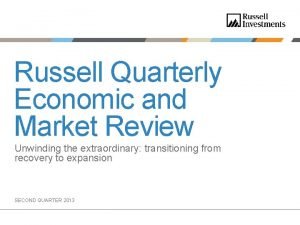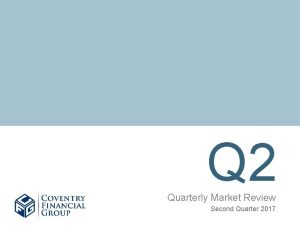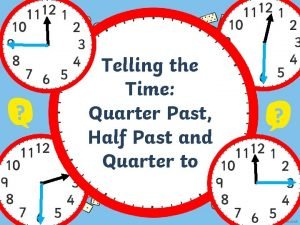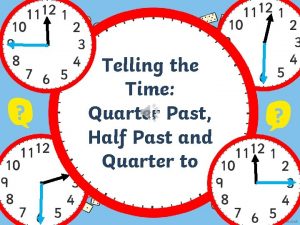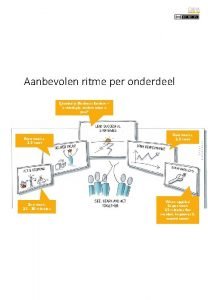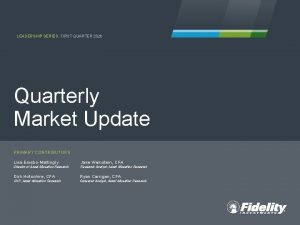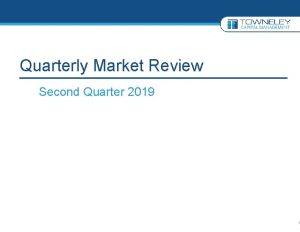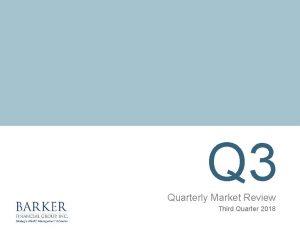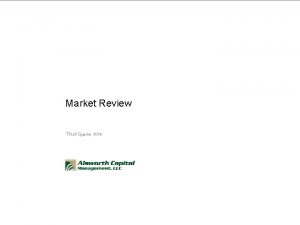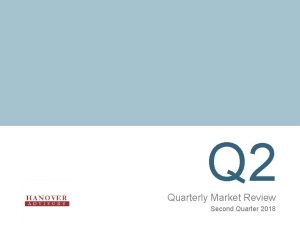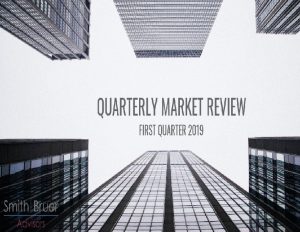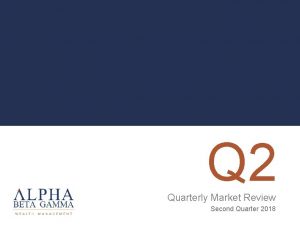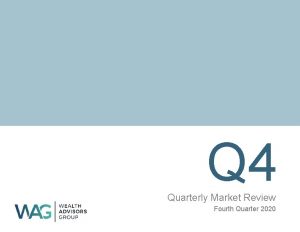Q 3 Quarterly Market Review Third Quarter 2017


















- Slides: 18

Q 3 Quarterly Market Review Third Quarter 2017

Quarterly Market Review Third Quarter 2017 This report features world capital market performance and a timeline of events for the past quarter. It begins with a global overview, then features the returns of stock and bond asset classes in the US and international markets. Overview: The report also illustrates the impact of globally diversified portfolios and features a quarterly topic. World Asset Classes Market Summary World Stock Market Performance US Stocks International Developed Stocks Emerging Markets Stocks Select Country Performance Select Currency Performance vs. US Dollar Real Estate Investment Trusts (REITs) Commodities Fixed Income Impact of Diversification Quarterly Topic: Stop Monkeying Around!

Market Summary Index Returns Past performance is not a guarantee of future results. Indices are not available for direct investment. Index performance does not reflect the expenses associated with the management of an actual portfolio. Market segment (index representation) as follows: US Stock Market (Russell 3000 Index), International Developed Stocks (MSCI World ex USA Index [net div. ]), Emerging Markets (MSCI Emerging Markets Index [net div. ]), Global Real Estate (S&P Global REIT Index [net div. ]), US Bond Market (Bloomberg Barclays US Aggregate Bond Index), and Global Bond ex US Market (Citi WGBI ex USA 1− 30 Years [Hedged to USD]). The S&P data are provided by Standard & Poor's Index Services Group. Frank Russell Company is the source and owner of the trademarks, service marks, and copyrights related to the Russell Indexes. MSCI data © MSCI 2017, all rights reserved. Bloomberg Barclays data provided by Bloomberg. Citi fixed income indices copyright 2017 by Citigroup. 3

World Stock Market Performance MSCI All Country World Index with selected headlines from Q 3 2017 “Eurozone Industrial Output Rises at Fastest Rate in Nearly Six Years” “US Homeownership Rate Jumps from 50 -Year Low” “Euro Jumps to Two -Year High after ECB Meeting” “US Companies Post Profit Growth Not Seen in Six Years” “China Maintains 6. 9% Economic Growth, Beating Expectations as Beijing Walks Tightrope” Jul “US Second. Quarter GDP Rose 3. 1%” “Global Inflation Hits Lowest Level since 2009” “Household Debt Hits Record as Auto Loans and Credit Cards Climb” “UK Jobless Rate Hits 42 -Year Low” “Dollar Hits Lowest Level in More than 2½Years” “Eurozone Consumer Sentiment Hits 16 Year High” “US Household Incomes Rose in “Moody’s 2016 to New Record” Downgrades UK’s Credit Rating” “US Factory-Sector Activity Hits Six-Year High” “UK Economy Posts Lackluster Growth” Aug Sep These headlines are not offered to explain market returns. Instead, they serve as a reminder that investors should view daily events from a long-term perspective and avoid making investment decisions based solely on the news. Graph Source: MSCI ACWI Index [net div. ]. MSCI data © MSCI 2017, all rights reserved. It is not possible to invest directly in an index. Performance does not reflect the expenses associated with management of an actual portfolio. Past performance is not a guarantee of future results. 4

World Stock Market Performance MSCI All Country World Index with selected headlines from past 12 months Short Term (Q 4 2016–Q 3 2017) 240 230 “Global Inflation Falls to Seven. Year Low” “Pound Drops to 31 -Year Low Against Dollar” 220 210 “Cyberattack Knocks Out Access to Websites” “Trump Wins” “Eurozone Confidence Hits Postcrisis High” 200 190 Long Term 180 Last 12 months (2000–Q 3 2017) 250, 00 170 “US Companies Post Profit Growth Not Seen in Six Years” “US Consumer Confidence Reaches Highest Level “US Household “Consumer Confidence since 2000” Debt Hit Record Hits Highest Level in First Quarter” “US Trade Deficit Last Year since 2001” Was Widest since 2012” “Fed Raises Interest Rates, Remains on Track to Keep Tightening” “Global Stocks Post Strongest First Half in Years, Worrying Investors” “Unemployment Rate Falls to 16 -Year Low, But Hiring Slows” “Dollar Hits Lowest Level in More than 2½ Years” “US Second. Quarter GDP Rose 3. 1%” “Household Debt Hits Record as Auto Loans and Credit Cards Climb” 200, 00 150, 00 100, 00 160 150 сен-2016 50, 00 2000 дек-2016 мар-2017 июн-2017 сен-2017 These headlines are not offered to explain market returns. Instead, they serve as a reminder that investors should view daily events from a long-term perspective and avoid making investment decisions based solely on the news. Graph Source: MSCI ACWI Index [net div. ]. MSCI data © MSCI 2017, all rights reserved. It is not possible to invest directly in an index. Performance does not reflect the expenses associated with management of an actual portfolio. Past performance is not a guarantee of future results. 5

World Asset Classes Third Quarter 2017 Index Returns (%) With broad market indices used as proxies, emerging markets outperformed developed markets, including the US, during the quarter. The value effect was positive in non-US developed markets but negative in the US and emerging markets. Small caps outperformed large caps in US and non-US developed markets but underperformed in emerging markets. MSCI Emerging Markets Index (net div. ) 7, 89 MSCI World ex USA Small Cap Index (net div. ) 7, 26 MSCI All Country World ex USA Index (net div. ) 6, 16 MSCI World ex USA Value Index (net div. ) 6, 14 Russell 2000 Index 5, 67 MSCI Emerging Markets Small Cap Index (net div. ) 5, 64 MSCI World ex USA Index (net div. ) 5, 62 MSCI Emerging Markets Value Index (net div. ) 5, 47 Russell 2000 Value Index 5, 11 Russell 3000 Index 4, 57 Russell 1000 Index 4, 48 S&P 500 Index 4, 48 Russell 1000 Value Index 3, 11 S&P Global ex US REIT Index (net div. ) 2, 19 Bloomberg Barclays US Aggregate Bond Index Dow Jones US Select REIT Index One-Month US Treasury Bills 0, 85 0, 38 0, 24 Past performance is not a guarantee of future results. Indices are not available for direct investment. Index performance does not reflect the expenses associated with the management of an actual portfolio. The S&P data is provided by Standard & Poor's Index Services Group. Frank Russell Company is the source and owner of the trademarks, service marks, and copyrights related to the Russell Indexes. MSCI data © MSCI 2017, all rights reserved. Dow Jones data (formerly Dow Jones Wilshire) provided by Dow Jones Indices. Bloomberg Barclays data provided by Bloomberg. Treasury bills © Stocks, Bonds, Bills, and Inflation Yearbook™, Ibbotson Associates, Chicago (annually updated work by Roger G. Ibbotson and Rex A. Sinquefield). 6

US Stocks Third Quarter 2017 Index Returns The broad US equity market posted positive returns for the quarter but underperformed both non-US developed and emerging markets. Value underperformed growth indices in the US across all size ranges. Ranked Returns for the Quarter (%) Small Growth 6, 22 Large Growth 5, 90 Small Cap Small caps in the US outperformed large caps. 5, 67 Small Value 5, 11 Marketwide 4, 57 Large Cap Large Value 4, 48 3, 11 World Market Capitalization—US 52% US Market $26. 0 trillion Past performance is not a guarantee of future results. Indices are not available for direct investment. Index performance does not reflect the expenses associated with the management of an actual portfolio. Market segment (index representation) as follows: Marketwide (Russell 3000 Index), Large Cap (Russell 1000 Index), Large Cap Value (Russell 1000 Value Index), Large Cap Growth (Russell 1000 Growth Index), Small Cap (Russell 2000 Index), Small Cap Value (Russell 2000 Value Index), and Small Cap Growth (Russell 2000 Growth Index). World Market Cap represented by Russell 3000 Index, MSCI World ex USA IMI Index, and MSCI Emerging Markets IMI Index. Russell 3000 Index is used as the proxy for the US market. Frank Russell Company is the source and owner of the trademarks, service marks, and copyrights related to the Russell Indexes. MSCI data © MSCI 2017, all rights reserved. 7

International Developed Stocks Third Quarter 2017 Index Returns In US dollar terms, developed markets outperformed US equity indices but underperformed emerging markets indices during the quarter. With broad market indices used as proxies, the value effect was positive. The value effect was positive in large caps but negative in mid and small caps. Overall, small caps outperformed large caps in non-US developed markets. Ranked Returns (%) Local currency 5, 12 Small Cap 7, 26 3, 86 Value Large Cap Growth US currency 6, 14 3, 41 5, 62 2, 96 5, 10 World Market Capitalization—International Developed 37% International Developed Market $18. 5 trillion Past performance is not a guarantee of future results. Indices are not available for direct investment. Index performance does not reflect the expenses associated with the management of an actual portfolio. Market segment (index representation) as follows: Large Cap (MSCI World ex USA Index), Small Cap (MSCI World ex USA Small Cap Index), Value (MSCI World ex USA Value Index), and Growth (MSCI World ex USA Growth). All index returns are net of withholding tax on dividends. World Market Cap represented by Russell 3000 Index, MSCI World ex USA IMI Index, and MSCI Emerging Markets IMI Index. MSCI World ex USA IMI Index is used as the proxy for the International Developed market. MSCI data © MSCI 2017, all rights reserved. Frank Russell Company is the source and owner of the trademarks, service marks, and copyrights related to the Russell Indexes. 8

Emerging Markets Stocks Third Quarter 2017 Index Returns In US dollar terms, emerging markets indices outperformed developed market indices, including the US, during the quarter. With broad market indices used as proxies, the value effect was negative. Across the size spectrum in the large and mid cap space, the value effect was negative; however, in the small cap space, the effect was positive. Overall, small caps underperformed large caps in emerging markets. Ranked Returns (%) Local currency 9, 86 10, 19 Growth 7, 58 7, 89 Large Cap Small Cap Value US currency 5, 44 5, 64 5, 17 5, 47 World Market Capitalization—Emerging Markets 11% Emerging Markets $5. 8 trillion Past performance is not a guarantee of future results. Indices are not available for direct investment. Index performance does not reflect the expenses associated with the management of an actual portfolio. Market segment (index representation) as follows: Large Cap (MSCI Emerging Markets Index), Small Cap (MSCI Emerging Markets Small Cap Index), Value (MSCI Emerging Markets Value Index), and Growth (MSCI Emerging Markets Growth Index). All index returns are net of withholding tax on dividends. World Market Cap represented by Russell 3000 Index, MSCI World ex USA IMI Index, and MSCI Emerging Markets IMI Index used as the proxy for the emerging market portion of the market. MSCI data © MSCI 2017, all rights reserved. Frank Russell Company is the source and owner of the trademarks, service marks, and copyrights related to the Russell Indexes. 9

Select Country Performance Third Quarter 2017 Index Returns In US dollar terms, Norway and Italy recorded the highest country performance in developed markets, while Israel posted the lowest—and only negative—return in developed markets. In emerging markets, Brazil, Russia, and Chile posted the highest country returns, while Pakistan and Greece had the lowest performance. Ranked Developed Markets Returns (%) Norway Italy Portugal Austria Netherlands Belgium Germany France Denmark Canada Ireland UK Sweden Hong Kong US Japan Spain Finland Singapore Australia New Zealand Switzerland Israel Ranked Emerging Markets Returns (%) 18, 36 13, 65 10, 94 10, 21 9, 35 8, 87 8, 72 8, 40 7, 95 7, 52 6, 63 5, 65 5, 08 4, 93 4, 45 4, 37 4, 11 3, 75 3, 41 3, 29 2, 49 2, 09 -8, 21 Brazil Russia Chile Peru China Thailand Czech Republic Hungary Poland Colombia UAE Egypt South Africa India Philippines Taiwan Malaysia Korea Mexico Turkey Indonesia Qatar Greece Pakistan 23, 78 17, 40 17, 26 15, 59 14, 49 9, 97 9, 75 9, 32 9, 16 6, 69 4, 14 3, 92 3, 39 2, 86 2, 43 1, 99 1, 72 1, 19 0, 61 -1, 56 -6, 82 -8, 77 -12, 37 Past performance is not a guarantee of future results. Indices are not available for direct investment. Index performance does not reflect the expenses associated with the management of an actual portfolio. Country performance based on respective indices in the MSCI World ex US IMI Index (for developed markets), MSCI USA IMI Index (for US), and MSCI Emerging Markets IMI Index. All returns in USD and net of withholding tax on dividends. MSCI data © MSCI 2017, all rights reserved. UAE and Qatar have been reclassified as emerging markets by MSCI, effective May 2014. 10

Select Currency Performance vs. US Dollar Third Quarter 2017 Currency performance was mixed in both developed and emerging markets. Among developed markets currencies, the Norwegian krone appreciated by 5%, while the Israeli shekel and the New Zealand dollar depreciated by approximately 1%. In emerging markets, the Brazilian real appreciated by almost 5%, while the South African rand depreciated by almost 3%. Ranked Developed Markets (%) Ranked Emerging Markets (%) Norwegian krone (NOK) 5, 23 Canadian dollar (CAD) 3, 84 Euro (EUR) 3, 65 Danish krone (DKK) 3, 56 Swedish krona (SEK) 3, 33 British pound (GBP) 3, 29 Australian dollar (AUD) 2, 29 Singapore dollar (SGD) 1, 39 Hong Kong dollar (HKD) -0, 05 Japanese yen (JPY) Swiss franc (CHF) -0, 18 -1, 03 Israel shekel (ILS) -1, 21 New Zealand dollar (NZD) -1, 27 Brazilian real (BRC) 4, 75 Czech koruna (CZK) 4, 14 Colombian peso (COP) 4, 03 Chilean peso (CLP) 4, 00 Hungary forint (HUF) 3, 13 Russian ruble (RUB) 2, 97 2, 66 Egyptian pound (EGP) Chinese yuan (CNY) 2, 06 Thailand baht (THB) 1, 86 Poland new zloty (PLZ) 1, 77 Malaysian ringgit (MYR) 1, 66 Taiwanese NT dollar (TWD) 0, 32 South Korean won (KRW) -0, 10 Mexican peso (MXP) -0, 33 Pakistani rupee (PKR) -0, 47 Peru new sol (PEI) -0, 61 Philippine peso (PHP) -0, 67 Turkish new lira (TRY) -0, 94 Indian rupee (INR) -1, 04 Indonesia rupiah (IDR) South African rand (ZAR) -1, 05 -2, 96 Past performance is not a guarantee of future results. Indices are not available for direct investment. Index performance does not reflect the expenses associated with the management of an actual portfolio. MSCI data © MSCI 2017, all rights reserved. 11

Real Estate Investment Trusts (REITs) Third Quarter 2017 Index Returns Non-US real estate investment trusts outperformed US REITs. Ranked Returns (%) Global REITs (ex US) US REITs 2, 19 0, 38 Total Value of REIT Stocks 41% World ex US $454 billion 250 REITs (23 other countries) 59% US $662 billion 103 REITs Past performance is not a guarantee of future results. Indices are not available for direct investment. Index performance does not reflect the expenses associated with the management of an actual portfolio. Number of REIT stocks and total value based on the two indices. All index returns are net of withholding tax on dividends. Total value of REIT stocks represented by Dow Jones US Select REIT Index and the S&P Global ex US REIT Index. Dow Jones US Select REIT Index used as proxy for the US market, and S&P Global ex US REIT Index used as proxy for the World ex US market. Dow Jones US Select REIT Index data provided by Dow Jones ©. S&P Global ex US REIT Index data provided by Standard and Poor's Index Services Group © 2017. 12

Commodities Third Quarter 2017 Index Returns The Bloomberg Commodity Index Total Return gained 2. 52% during the third quarter. Ranked Returns for Individual Commodities (%) Heating Oil The energy complex led advancing commodities, with heating oil returning 20. 97%, Brent crude oil 15. 32%, unleaded gas 14. 49%, and WTI crude oil 10. 90%. Grains was the worst-performing complex, with Kansas wheat and Chicago wheat declining 21. 15% and 19. 67%, respectively. Lean hogs also experienced a decline, decreasing by 10. 94%. 20, 97 Brent Oil 15, 32 Zinc 14, 58 Unleaded Gas 14, 49 Nickel 11, 03 WTI Crude Oil 10, 90 Aluminum 8, 32 Copper 8, 22 Gold 2, 82 Soybean Meal 1, 48 Soybeans 1, 41 Cotton -0, 20 Silver -0, 22 Coffee -0, 61 Soybean Oil -1, 56 Sugar -1, 60 Natural Gas -4, 32 Live Cattle -5, 78 Corn -10, 20 Lean Hogs Wheat Kansas Wheat -10, 94 -19, 67 -21, 15 Past performance is not a guarantee of future results. Index is not available for direct investment. Index performance does not reflect the expenses associated with the management of an actual portfolio. All index returns are net of withholding tax on dividends. Securities and commodities data provided by Bloomberg. 13

Fixed Income Third Quarter 2017 Index Returns Interest rates increased across the US fixed income market for the quarter. The yield on the 5 -year Treasury note increased by 3 basis points (bps) to 1. 92%. The yield on the 10 -year Treasury note increased by 2 bps to 2. 33%. The 30 -year Treasury bond yield increased by 2 bps to finish at 2. 86%. The yield on the 1 -year T-bill rose 7 bps to 1. 31%, and the 2 -year Treasury note yield rose 9 bps to 1. 47%. The yield on the 3 -month Treasury bill increased 3 bps to 1. 06%, while the 6 -month Treasury bill yield increased 6 bps to 1. 20%. US Treasury Yield Curve (%) Bond Yields across Issuers (%) 4 43007 42916 42643 3 2, 89 2, 33 3, 27 2, 70 2 1 0 1 Yr 5 Yr 10 Yr 30 Yr 10 -Year US Treasury Municipals AAA-AA Corporates A-BBB Corporates In terms of total returns, short-term corporate bonds gained 0. 59%, and intermediate-term corporates gained 1. 05%. Short-term municipal bonds generated a total return of 0. 49%, while intermediateterm municipal bonds returned 0. 83%. General obligation bonds gained 1. 14%, outperforming revenue bonds by 4 bps. One basis point equals 0. 01%. Past performance is not a guarantee of future results. Indices are not available for direct investment. Index performance does not reflect the expenses associated with the management of an actual portfolio. Yield curve data from Federal Reserve. State and local bonds are from the S&P National AMT-Free Municipal Bond Index. AAA-AA Corporates represent the Bank of America Merrill Lynch US Corporates, AA-AAA rated. A-BBB Corporates represent the Bank of America Merrill Lynch US Corporates, BBB-A rated. Bloomberg Barclays data provided by Bloomberg. US long-term bonds, bills, inflation, and fixed income factor data © Stocks, Bonds, Bills, and Inflation (SBBI) Yearbook™, Ibbotson Associates, Chicago (annually updated work by Roger G. Ibbotson and Rex A. Sinquefield). Citi fixed income indices copyright 2017 by Citigroup. The Bof. A Merrill Lynch Indices are used with permission; © 2017 Merrill Lynch, Pierce, Fenner & Smith Incorporated; all rights reserved. Merrill Lynch, Pierce, Fenner & Smith Incorporated is a wholly owned subsidiary of Bank of America Corporation. The S&P data are provided by Standard & Poor's Index Services Group. 14

Impact of Diversification Third Quarter 2017 Index Returns These portfolios illustrate the performance of different global stock/bond mixes. Mixes with larger allocations to stocks are considered riskier but have higher expected returns over time. Ranked Returns (%) 100% Stocks 5, 31 75/25 4, 03 50/50 2, 76 25/75 100% Treasury Bills 1, 50 0, 24 Growth of Wealth: The Relationship between Risk and Return Stock/Bond Mix $100 000 100% Stocks $80 000 75/25 $60 000 50/50 $40 000 25/75 100% Treasury Bills $20 000 $0 12. 1988 12. 1993 12. 1998 12. 2003 12. 2008 12. 20139/2017 1. STDEV (standard deviation) is a measure of the variation or dispersion of a set of data points. Standard deviations are often used to quantify the historical return volatility of a security or portfolio. Diversification does not eliminate the risk of market loss. Past performance is not a guarantee of future results. Indices are not available for direct investment. Index performance does not reflect expenses associated with the management of an actual portfolio. Asset allocations and the hypothetical index portfolio returns are for illustrative purposes only and do not represent actual performance. Global Stocks represented by MSCI All Country World Index (gross div. ) and Treasury Bills represented by US One-Month Treasury Bills. Globally diversified allocations rebalanced monthly, no withdrawals. Data © MSCI 2017, all rights reserved. Treasury bills © Stocks, Bonds, Bills, and Inflation Yearbook™, Ibbotson Associates, Chicago (annually updated work by Roger G. Ibbotson and Rex A. Sinquefield). 15

Quit Monkeying Around! Third Quarter 2017 In the world of investment management there is an oft -discussed idea that blindfolded monkeys throwing darts at pages of stock listings can select portfolios that will do just as well, if not better, than both the market and the average portfolio constructed by professional money managers. If this is true, why might it be the case? also be an investor underweight that same stock, this means that, in aggregate, the average dollar invested holds a portfolio that looks like the overall market. 1 Exhibit 1. US Stocks Sized by Market Capitalization The Dart Board Exhibit 1 shows the components of the Russell 3000 Index (regarded as a good proxy for the US stock market) as of December 31, 2016. Each stock in the index is represented by a box, and the size of each box represents the stock’s market capitalization (share price multiplied by shares outstanding) or “market cap” in the index. For example, Apple (AAPL) is the largest box since it has the largest market cap in the index. The boxes get smaller as you move from the top to the bottom of the exhibit, from larger stocks to smaller stocks. The boxes are also color coded based on their market cap and whether they are value or growth stocks. Value stocks have lower relative prices (as measured by, for instance the price-to-book ratio) and growth stocks tend to have higher relative prices. In the exhibit, blue represents large cap value stocks (LV), green is large cap growth stocks (LG), gray is small cap value stocks (SV), and yellow is small cap growth stocks (SG). For the purposes of this analogy you can think of Exhibit 1 as a proxy for the overall stock market and therefore similar to a portfolio that, in aggregate, professional money managers hold in their competition with their simian challengers. Because for every investor holding an overweight to a stock (relative to its market cap weighting) there must 1. For more on this concept, please see “ The Arithmetic of Active Management ” by William Sharpe. For illustrative purposes only. Illustration includes constituents of the Russell 3000 Index as of December 31, 2016, on a market-cap weighted basis segmented into Large Value, Large Growth, Small Value, and Small Growth. Source: Frank Russell Company is the source and owner of the trademarks, service marks, and copyrights related to the Russell Indexes. Please see Appendix for additional information. 16

Quit Monkeying Around! (continued from page 16) Exhibit 2, on the other hand, represents the dart board the monkeys are using to play their game. Here, the boxes represent the same stocks shown in Exhibit 1, but instead of weighting each company by market cap, the companies are weighted equally. For example, in this case, Apple’s box is the same size as every other company in the index regardless of its market cap. If one were to pin up pages of newspaper stock listings to throw darts at, Exhibit 2 would be much more representative of what the target would look like. prices change, so will each individual holding’s respective weight in the portfolio. By not considering whether or not these frequent trades add value over and above the costs they generate, investors are opening themselves up to a potentially less than desirable outcome. Exhibit 2. US Stocks Sized Equally When looking at Exhibits 1 and 2, the significant differences between the two are clear. In Exhibit 1, the surface area is dominated by large value and large growth (blue and green) stocks. In Exhibit 2, however, small cap value stocks dominate (gray). Why does this matter? Research has shown that, historically over time, small company stocks have had excess returns relative to large company stocks. Research has also shown that, historically over time, value (or low relative price) stocks have had excess returns relative to growth (or high relative price) stocks. Because Exhibit 2 has a greater proportion of its surface area dedicated to small cap value stocks, it is more likely that a portfolio of stocks selected at random by throwing darts would end up being tilted towards stocks which research has shown to have had higher returns when compared to the market. So…Throw Away? This does not mean, however, that haphazardly selecting stocks by the toss of a dart is an efficient or reliable way to invest. For one thing, it ignores the complexities that arise in competitive markets. Consider as an example something seemingly as straightforward as a strategy that holds every stock in the Russell 3000 Index at an equal weight (the equivalent of buying the whole dart board in Exhibit 2). In order to maintain an equal weight in all 3, 000 securities, an investor would have to rebalance frequently, buying shares of companies that have gone down in price and selling shares that have gone up. This is because as For illustrative purposes only. Illustration includes the constituents of the Russell 3000 Index as of December 31, 2016 on an equal-weighted basis segmented into Large Value, Large Growth, Small Value, and Small Growth. Source: Frank Russell Company is the source and owner of the trademarks, service marks, and copyrights related to the Russell Indexes. Please see Appendix for additional information. 17

Quit Monkeying Around! (continued from page 17) Instead, if there are well-known relationships that explain differences in expected returns across stocks, using a systematic and purposeful approach that takes into consideration real-world constraints is more likely to increase your chances for investment success. Considerations for such an approach include things like: understanding the drivers of returns and how to best design a portfolio to capture them, what a sufficient level of diversification is, how to appropriately rebalance, and last but not least, how to manage the costs associated with pursuing such a strategy. The Long Game Finally, the importance of having an asset allocation well suited for your objectives and risk tolerance, as well as being able to remain focused on the long term, cannot be overemphasized. Even well-constructed portfolios pursuing higher expected returns will have periods of disappointing results. A financial advisor can help an investor decide on an appropriate asset allocation, stay the course during periods of disappointing results, and carefully weigh the considerations mentioned above to help investors decide if a given investment strategy is the right one for them. So what insights can investors glean from this analysis? First, by tilting a portfolio towards sources of higher expected returns, investors can potentially outperform the market without needing to outguess market prices. Second, implementation and patience are paramount. If one is going to pursue higher expected returns, it is important to do so in a costeffective manner and to stay focused on the long term. Appendix Large cap is defined as the top 90% of market cap (small cap is the bottom 10%), while value is defined as the 50% of market cap of the lowest relative price stocks (growth is the 50% of market cap of the highest relative price stocks). For educational and informational purposes only and does not constitute a recommendation of any security. The determinations of Large Value, Large Growth, Small Value, and Small Growth do not represent any determinations Dimensional Fund Advisors may make in assessing any of the securities shown. Conclusion Source: Dimensional Fund Advisors LP. There is no guarantee investment strategies will be successful. Investing involves risks including possible loss of principal. Diversification does not eliminate the risk of market loss. All expressions of opinion are subject to change. This article is distributed for informational purposes, and it is not to be construed as an offer, solicitation, recommendation, or endorsement of any particular security, products, or services. 18
 Russell quarterly economic and market review
Russell quarterly economic and market review Russell quarterly economic and market review
Russell quarterly economic and market review A quarter past 5
A quarter past 5 Clock showing half past 6
Clock showing half past 6 Quarterly business review examples
Quarterly business review examples Business review template
Business review template Quarterly business review templates
Quarterly business review templates Quarterly business review
Quarterly business review Fidelity quarterly market update q1 2018
Fidelity quarterly market update q1 2018 What does a crescent moon mean
What does a crescent moon mean How many bones does a dog have
How many bones does a dog have Hypothetical market structure
Hypothetical market structure Steps in market segmentation targeting and positioning
Steps in market segmentation targeting and positioning Gingival third vs cervical third
Gingival third vs cervical third G j mount classification of caries
G j mount classification of caries Spears and associates
Spears and associates Access quarterly package
Access quarterly package Gantt chart notes
Gantt chart notes Kpis template
Kpis template
